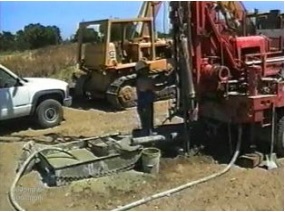
One of the ways that the residential codes are more permissive than general building codes is their treatment of geotechnical investigations. Conventional residential construction is lightweight and the prescriptive foundation design provisions in the code are very conservative, yet typically cost-effective. There are circumstances, however, when performing a geotechnical investigation is beneficial or necessary for a residential project. Therefore, the decision as to whether to perform a geotechnical investigation warrants more attention then it usually receives.
Most jurisdictions have adopted some version of the International Residential Code (IRC) to govern residential construction. The general approach of the IRC is to take advantage of residential construction conventions to provide widely applicable prescriptive design options. This allows homeowners, contractors and building officials to design, construct and permit safe and cost-effective dwellings without the need for the involvement of design professionals (i.e. architects and engineers). The motivation for this is tradition – residential construction has traditionally not required the services of design professionals – and to avoid the expense of design professionals for simple, conventional construction, which can be disproportionately high.
To avoid the need for engineering of foundations for conventionally constructed dwellings, the IRC provides tables for proportioning and detailing foundations based on the configuration of the building, the bearing capacity of the ground and some loading assumptions. The bearing capacity can be selected from a table, without a geotechnical evaluation, based on the soil (or rock) in the foundation excavations. These bearing capacity values do not account for the actual strength and stiffness of the soil; in fact, they are extremely conservative. But because conventional residential construction is lightweight, little is usually gained by a more refined approach.
Given this conservative process, the information typically obtained from a geotechnical investigation is unnecessary. Therefore, the IRC requires a geotechnical evaluation only when “quantifiable data…indicate that expansive, compressible, shifting or otherwise questionable soil characteristics are likely to be present” and the building official determines that it is necessary (IRC 2015 R401.4).
There is, however, another code pathway to a geotechnical exploration being required. The IRC allows residential construction to contain structural elements that are outside of the prescriptive provisions. These “nonconventional” elements must be designed in accordance with “accepted engineering practice” and design according to the International Building Code (IBC) is specifically permitted (IRC 2015 R301.1.3). The IBC contains more provisions triggering a mandatory geotechnical investigation and they are performed for most nonresidential building projects.
The use of pile foundations for residential buildings is outside the IRC provisions and can be designed according to the IBC. Piles are driven or drilled into the soil, usually without the ability to observe the supporting bearing soil. Piles are used when soils near the surface are unsuitable to provide foundation support or cannot be excavated practically. They are also commonly used for buildings in flood zones to elevate the structure and resist foundation movement due to scouring. According to the IBC, geotechnical investigations are
Some of the circumstances that trigger the need for a geotechnical investigation for a nonresidential building in the IBC apply to residential construction as well, although the same triggers do not exist in the IRC. For example, unsuitable soils like fills and organic silts and clays can behave unpredictably under foundation loads. Shallow groundwater can cause basement moisture infiltration, mildew and mold. The presence of unsuitable soils or shallow groundwater can compromise the performance of a residential foundation. In these cases, an investigation may be advisable while not mandatory. Costly design changes and construction delays can occur if these conditions are first discovered during construction.
A geotechnical investigation can also identify subsurface conditions that will lead to construction problems. Excavation and subgrade preparation in unsuitable soils can necessitate the use of special techniques and stabilization measures. The removal of unexpected obstructions in fill or rock outcrops may force the mobilization of additional equipment. High groundwater may have to be lowered to allow foundation construction, requiring pumping systems. Identifying these conditions in advance can provide greater certainty in budgeting and contractor bids. If contractors knows they will encounter groundwater or loose soil, they can plan for it. If additional equipment or subcontractors have to be brought to the site after discovering an adverse condition during construction, the work will cost more than if it was planned from the onset and delays will be likely.
A lot of the conditions that warrant geotechnical investigations are present on waterfront sites. These sites are typically in low-lying areas that may be flood zones. Depending on the nature of the hazard, pile foundations may be required. Depending on the local geography, the foundation may bear on
Rather than assume that a geotechnical investigation is inherently unnecessary for residential projects, architects, contractors and building officials should consider whether risks due to the proposed construction or the site can be better managed if subsurface data from an investigation were available. Consider obtaining a geotechnical investigation for projects on the following types of sites:
- Waterfront sites;
- Urban areas with lot-line construction;
- Steeply sloping sites;
- Sites with rock outcrops;
- Karst and expansive soil regions.
If a geotechnical investigation appears to be warranted, a proper scope needs to be determined. This should not be viewed as pro forma exercise or a commodity whereby a standard report can be obtained at the lowest cost. Consider what information is required and who will use it. Do any code requirements apply? Most investigations include borings, but there are multiple ways of making borings, each with advantages and disadvantages. Sometimes test pits or probes are more cost-effective. If not required by a building official, a report may not be required and the logs of the exploration may suffice. Laboratory testing should be specified only if justified by the anticipated conditions. Each item in the scope should have some project-specific rationale to justify its cost, based on the needs of the relevant stakeholders.
While code requirements rarely require that a geotechnical investigation is performed for a residential construction project, it can be a good idea anyway. The investigation can reveal subsurface conditions that will create adversities during construction, diminish foundation performance, require mitigation or delay construction, all of which increase the cost and risk associated with the project. The information derived from the investigation can allow these conditions to be addressed during the design phase when changes are less expensive and risky. When adverse subsurface conditions are expected, a geotechnical investigation can be a worthwhile investment.
The information and statements in this document are for information purposes only and do not comprise the professional advice of the author or create a professional relationship between reader and author.
See also: Investigations & Consulting

